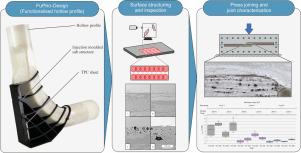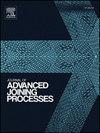Improving the joint strength of thermoplastic composites joined by press joining using laser-based surface treatment
IF 4
Q2 MATERIALS SCIENCE, MULTIDISCIPLINARY
引用次数: 0
Abstract
Fibre-reinforced thermoplastic composites (TPC) provide an automated and cost-effective solution for their use in lightweight structures in series production. The combination of different material configurations allows the design of highly stress tolerant components. Previous studies demonstrated that the combination of TPC sheets, TPC hollow profiles and injection moulding compounds is even suitable for crash-relevant automotive parts. All three components are combined during the injection moulding process. To prevent collapse, the part must remain in a consolidated state and cannot be preheated. However, this results in poor adhesion between the hollow profile, the bulk material, and the TPC sheet. Previous studies have shown that the bonding strength between the hollow profile and the injection moulding compound can be increased by surface pre-treatment using laser structuring and plasma technology. In this work, laser structuring is employed to enhance the bonding strength between the hollow profile and the TPC sheet. Microscopy analysis is used to investigate the resulting surface morphology. Subsequently, single-lap-shear (SLS) specimens are produced by pressing the TPC sheets onto the flat part. The resulting bonding strengths are then evaluated by tensile shear tests. The study analyses the impact of various pre-treatment parameters on the bonding strength. Furthermore, it investigates the effect of sheet temperature on the bonding strength, including specimens without pre-treatment. Finally, the results of the surface treatment of hollow composite profiles are discussed.

利用激光表面处理技术提高热塑性复合材料的接合强度
纤维增强热塑性复合材料(TPC)为轻质结构的批量生产提供了自动化和经济高效的解决方案。将不同的材料配置组合在一起,可以设计出具有高度应力承受能力的部件。先前的研究表明,TPC 板材、TPC 中空型材和注塑化合物的组合甚至适用于与碰撞有关的汽车部件。在注塑成型过程中,这三种成分会结合在一起。为防止塌陷,部件必须保持固结状态,且不能预热。然而,这会导致中空型材、散装材料和 TPC 片材之间的粘合力较差。以往的研究表明,通过使用激光成型和等离子技术进行表面预处理,可以提高中空型材与注塑模具之间的粘合强度。在这项工作中,采用了激光成型技术来提高中空型材与 TPC 板材之间的粘合强度。显微镜分析用于研究由此产生的表面形态。随后,通过将 TPC 片材压到平面部件上,制作出单层剪切(SLS)试样。然后通过拉伸剪切试验评估粘接强度。研究分析了各种预处理参数对粘接强度的影响。此外,还研究了板材温度对粘接强度的影响,包括未进行预处理的试样。最后,还讨论了空心复合材料型材表面处理的结果。
本文章由计算机程序翻译,如有差异,请以英文原文为准。
求助全文
约1分钟内获得全文
求助全文

 求助内容:
求助内容: 应助结果提醒方式:
应助结果提醒方式:


